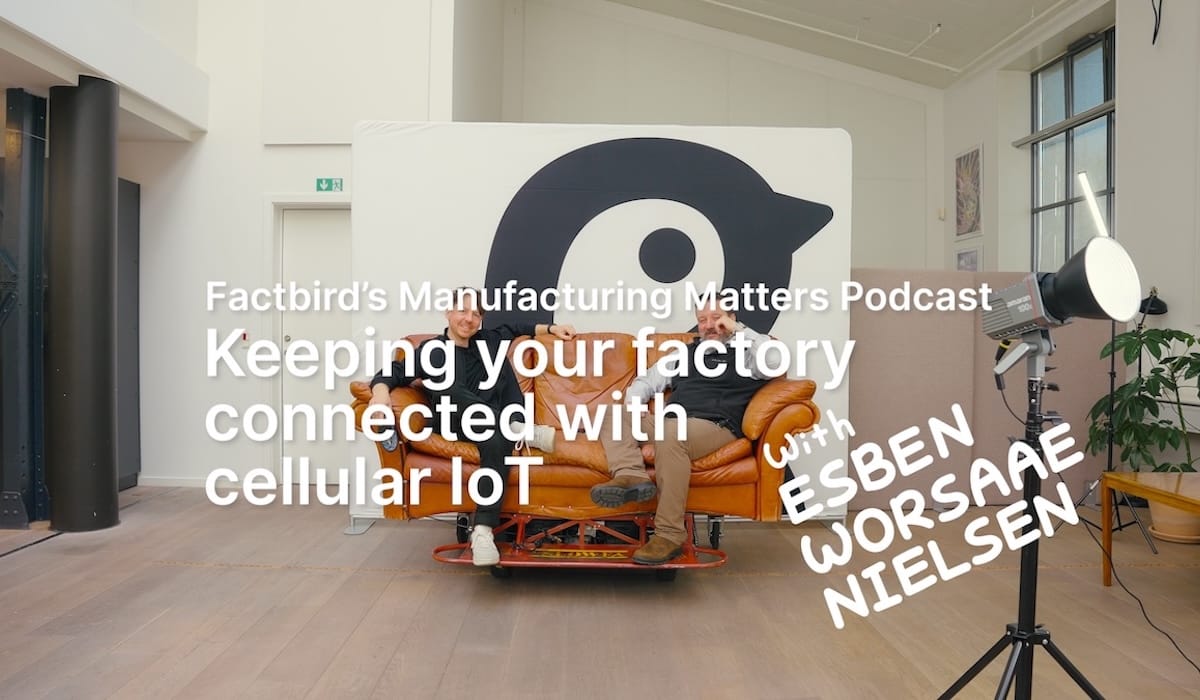How cellular IoT supports your journey to a smart connected factory
Manufacturing Matters S02E01
Featuring Esben Worsaae Nielsen, IoT expert
Release date: July 4, 2025

If you’re on a journey to become a smart factory, or just a smarter one, connectivity is essential. As you connect more machines, sensors, and systems, you need a reliable way to get data from the shop floor to the people and tools that can use it.
That’s where cellular IoT comes in. It’s a practical solution already helping manufacturers monitor equipment, track assets, and make better decisions in real time.
We spoke with Esben Worsaae Nielsen at Onomondo, a global cellular infrastructure provider, to understand why cellular IoT is gaining traction and how manufacturers can use it to build more agile, more connected operations.
Cellular vs. Wi-Fi vs. Ethernet
Most factories today use a mix of connectivity types. But cellular offers a few clear advantages, especially when you’re trying to scale across legacy sites or temporary installations.
Ethernet is reliable but requires wiring and IT involvement.
Wi-Fi works well but also requires IT involvement and is prone to outages.
Cellular is secure, robust, easy to deploy, and works independently of your internal infrastructure.
What is cellular IoT?
According to Esben, cellular IoT is “using cellular networks to have devices talk to each other, M2M, machine to machine, and using the normal, understandable radio technology. So 2G, 3G, 4G, 5G.”
In other words, cellular IoT enables machines to communicate using existing mobile networks. That means you don’t need to rely on factory Wi-Fi or install Ethernet cabling. As long as there’s signal, it works.
Why manufacturers are using cellular
In today’s world, where data is considered, by some, to be the most important commodity a factory has, cellular is a really good way of getting your data to a cloud server where software can help make it useful for you.
According to Esben, “You're never going to have the computing power of Amazon or Microsoft in your factory. So you want to get data out. You need to get it out because it's not a sustainable setup to have it on-prem.”
Additionally, connectivity can be a real bottleneck in manufacturing. Legacy infrastructure and operations spread across multiple sites or areas where Wi-Fi and Ethernet don’t reach cause headaches.
Cellular gives you another option, one that’s independent of internal networks and works globally with no setup required when working with the right partner.
“The infrastructure is there, and it's very, very much global.”
Cellular can also give you a layer of redundancy you don’t get with Wi-Fi or Ethernet alone.
If someone in the IT department pushes a firmware update or if your factory network goes down, your data will continue to flow as long as you have cellular IoT as a fallback option.
That kind of resilience is critical when you’re trying to reduce seriously expensive downtime or monitor critical systems.
Without getting too much into the weeds, it’s important to note that an additional advantage of modern mobile virtual network operators (MVNOs) like Onomondo is that they offer connectivity to multiple mobile networks at the same time, giving devices cellular fallback options in case one network goes down.
Real-world use cases
Esben walked us through several scenarios where cellular is already creating value.
Predictive maintenance
By transmitting usage data to the cloud in real time, you can accurately analyze when equipment needs servicing and reduce maintenance-related downtime.
“Being able to make sure that when you send people out, you don't send them out because it's needed now, but because it's going to be needed in two months' time.”
CNC machine monitoring
CNC machines are expensive and critical to production in many industries.
With dozens of sensors monitoring heat, humidity, motion, and even the presence of people or animals, cellular helps the reliable transmission of that data in real time.
Environmental and structural monitoring
Cellular-connected sensors can track everything from vibration to air quality, even on assets outside the main factory.
Cellular-enabled IoT devices that monitor environmental parameters are typically easy to place in whatever corner, area, ceiling, or line you need them, then turn on and start monitoring.
Private networks and 5G
Some manufacturers are exploring private cellular networks for greater control, security, and redundancy.
According to Esben, with private wireless networks, “You will be able to have full ownership of your connectivity on the factory floor.”
And while 5G is not a silver bullet, it’s starting to help reduce latency and improve device management.
“Historically, latency has been the big thing... 5G has the ability to help a lot on the device management because suddenly you have the latency aspects getting more manageable.”
Challenges and best practices
Here are a few tips for smart connected factories Esben shared during the chat.
Understand your environment:
Cellular isn’t without its quirks. On factory floors filled with metal, connectivity can be patchy for radiowave-based connectivity such as Wi-Fi and cellular networks. And like any connectivity method, it’s important to plan carefully.
“You came in black spots... there's a lot of electricity flying around.”
Walk your facility to identify potential signal issues. This is something you can also test in collaboration with cellular providers.
Know your data needs:
Not all data is created equal, and not every use case needs real-time updates. Ask yourself what you actually need to send to the cloud and how often.
Are you streaming high-resolution video or just sending sensor values every minute? Do you need full visibility in real time, or will daily summaries do the job? Getting clarity on this upfront will help you choose the right cellular technology and avoid overpaying for bandwidth or underestimating latency.
As Esben said, “How many times do you need to have data coming from your devices? Is it daily? Is it weekly? Is it per minute? Is it real time?”
These are all questions that you or manufacturers of IIoT edge devices, such as Factbird, need to figure out early.
Design for connectivity from the start:
“Bring in the connectivity partner as early as possible... Don’t build everything and then go ‘oh yeah, by the way, we need a SIM card.’”
He also pointed out that cellular is not a fixed technology. As networks evolve, modems and protocols change, so plan with longevity in mind.
“If you're depending on a modem that only has a certain spectrum... that could potentially be sunset.”
So it’s important to work with partners who can figure out these things for you. Developing a cellular IoT device involves many complexities that you should not have to manage yourself.
The bottom line
Cellular IoT gives manufacturers a flexible, scalable way to bring data online without waiting for IT, rewiring facilities, or relying on fragile Wi-Fi setups.
Whether it’s legacy equipment, remote assets, or high-value machines, cellular can help you get the data you need to reduce downtime, plan proactively, and take another step toward a more connected operation.
And as Esben reminded us, it’s not just about connectivity; it’s about thinking long-term.
“Let’s try to be smart about this... Connectivity isn’t just infrastructure; it’s part of your long-term factory strategy.”
Stay connected with the podcast
For more insights into manufacturing technology, subscribe to Factbird’s Manufacturing Matters podcast on Spotify, Apple Podcasts, YouTube, Amazon Music, or your favorite podcast platform.
If you have questions or topics you'd like us to cover, feel free to reach out via LinkedIn or email.


.svg.png)


